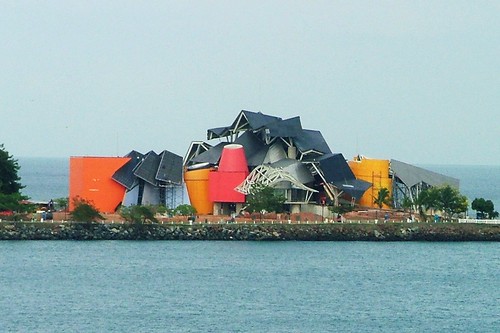I had come into town a day early to try to set up a ride on a sailboat through the Panama Canal, working as a line handler. Even on the 26´ boat that I would be crossing on, they were required to have 4 line handlers to secure the lines rapidly for the boat within the locks. The evening prior I had emailed Adriana on short notice to see whether I could add a night to my 2-night stay at her family´s place; however, she already had a couchsurfing guest, so she had arranged for me to stay at a hostel.
After dropping my bags at the hostel, my host took me for a brief tour of the neighborhood before heading out for dinner to the causeway. One of the more famous tourist attractions of Panama City, the Amador Causeway had been built to link the city to 4 islands located near the mouth of the canal. It now houses several marinas full of boats waiting to transit the canals, an unfinished bio-diversity museum designed by Frank Gehry, and multitudinous shops and restaurants to support the marinas and tourists.
 |
| Frank Gehry´s Museum of Biodiversity |
It reminds me of the French Quarter of New Orleans, and was granted world heritage site status by Unesco in 1998 due to its representation of architectural styles, particularly French and Early American. I spent 6 hours walking around, taking photos, exploring back streets, and building interiors. There is currently an exposition of artists in public places throughout Casco Viejo (murals, sculptures, graffiti) that made the old town even more appealing. The area is in an intense transition; construction is happening everywhere as the second wave of investment since the US vacated the canal zone in 1999 hits full stride. One of the guys on the streets of Casco Viejo who tried to hustle me yesterday to allow him to be my tour guide made an estimate that within 3 years the entire area will have been renovated. I´d say that his guess is about as good as any. An Australian from Perth who was staying at the hostel was in town to buy property in Casco Viejo in the $500K to $1 million range as an investment. His estimate was that the investment would triple in 5 years.
Regardless of the financial aspects of investing in Casco Viejo, it is simply one of the most beautiful aspects of a city steeped in a rich, historical past and an emerging future.
Regardless of the financial aspects of investing in Casco Viejo, it is simply one of the most beautiful aspects of a city steeped in a rich, historical past and an emerging future.